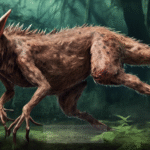What Happened to the Mokele-Mbembe: The Legendary Dinosaur of the Congo?
What Happened to the Mokele-Mbembe: The Legendary Dinosaur of the Congo?
The Mokele-Mbembe has captivated the imaginations of cryptozoologists and adventurers alike for decades. This creature, often described as resembling a sauropod dinosaur, allegedly roams the rivers and swamps of the Congo River Basin. The question of its existence raises significant intrigue as well as skepticism. Why does the search for the Mokele-Mbembe matter in the broader context of cryptozoology and scientific inquiry? This exploration delves into the history, evidence, and implications surrounding this legendary creature, offering insights into the enigmatic world of cryptids.
Historical Context of the Mokele-Mbembe
The legend of the Mokele-Mbembe originates from the local tribes in the Congo, particularly the Bakuba, who describe it as a large, water-dwelling creature with a long neck and tail. Historical accounts date back to the late 19th century when Western explorers first reported hearsay of such a beast. The term “Mokele-Mbembe” translates to “one who stops the flow of rivers,” suggesting its immense size and power over the waterways.
In 1910, the American explorer and paleontologist, William H. McRae, published an article in the “Scientific American” detailing his expedition into the Congo, during which he claimed to have encountered the creature. His writings fueled interest and speculation, prompting further expeditions throughout the 20th century. The Mokele-Mbembe quickly became a subject of significant interest in both cryptozoology and folklore, inspiring countless expeditions and documentaries seeking to uncover its existence.
Core Concepts and Theories
Many theories have arisen regarding the nature of the Mokele-Mbembe. Some cryptozoologists posit that it could be a surviving species of dinosaur, perhaps related to the long-extinct sauropods. Other theories suggest it may be a misidentified animal, such as an elephant or a hippo. The concept of “living fossils,” organisms that have remained unchanged for millions of years, adds a layer of complexity to the debate.
Researcher and cryptozoologist Dr. Karl P. N. Greer has proposed that the Mokele-Mbembe might belong to a small, undiscovered population of dinosaurs that survived in isolated areas of the Congo, adapting to local ecosystems. This theory aligns with the discovery of other prehistoric species believed to have existed in isolated habitats, like the Coelacanth, a fish thought to have been extinct for millions of years until its rediscovery in 1938.
Evidence and Sightings
Despite numerous expeditions, concrete evidence of the Mokele-Mbembe remains elusive. Over the years, several sightings have been reported, often describing a creature that is approximately 30 feet long, with a long neck and a large body. One of the most notable sightings occurred in 1981 when a team of scientists, led by Dr. Roy P. Mackal, ventured into the Congo Basin and claimed to have observed the creature from a distance.
While they did not capture any definitive evidence, their descriptions and sketches reignited interest in the Mokele-Mbembe. Additionally, some photographic evidence has surfaced, but skeptics argue that these images could easily be manipulated or misidentified animals. The lack of verified physical evidence — such as bones or genetic material — continues to challenge the credibility of Mokele-Mbembe claims.
| Year | Event | Details |
|---|---|---|
| 1981 | Dr. Roy P. Mackal Expedition | Team claimed to have sighted the creature but found no physical evidence. |
| 2005 | Expedition by Dr. David W. W. Dops | Reported sightings but faced criticism for lack of scientific method. |
| 2016 | Documentary by Discovery Channel | Explored various claims and sightings, but no definitive evidence was presented. |
Alternative Perspectives: Skepticism and Scientific Inquiry
While the allure of the Mokele-Mbembe persists, skepticism is a critical perspective within the scientific community. Many scientists argue that the ongoing lack of physical evidence suggests that the creature likely does not exist. This skepticism is often grounded in the principles of empirical evidence and reproducibility, which demand tangible proof to substantiate claims.
Furthermore, biologists emphasize the ecological implications of a large creature surviving in the densely populated and exploited environment of the Congo. The region faces threats from deforestation, poaching, and habitat destruction, which raises questions about how a sizable, elusive creature could sustain itself. Moreover, the possibility of undiscovered species existing in remote areas, while not impossible, becomes increasingly unlikely given current ecological pressures.
Common Misconceptions About Cryptids
One common misconception about creatures like the Mokele-Mbembe is that they are simply folklore or myth. While many cryptids have origins in cultural stories, their existence often reflects deeper human curiosity about the unknown and the possibility of undiscovered life forms. The Mokele-Mbembe, specifically, serves as a symbol of the intersection between scientific inquiry and mythological storytelling.
Another misconception is that all cryptid sightings are hoaxes. While some may be fabricated, many witnesses genuinely believe they have encountered something extraordinary. The psychological and sociocultural factors that contribute to these beliefs are complex and often overlooked in discussions about cryptozoology.
Best Practices for Investigating Cryptids
For those interested in investigating cryptids like the Mokele-Mbembe, a structured approach is essential. Here are some best practices to consider:
- Research Thoroughly: Familiarize yourself with historical accounts and existing literature on the subject.
- Gather Evidence: Document sightings and experiences in a detailed manner, noting time, location, and conditions.
- Engage with Experts: Collaborate with scientists and zoologists who can provide insight into possible explanations.
- Maintain Skepticism: Approach claims critically and be open to the possibility of misidentification.
- Respect Local Cultures: Acknowledge and engage with local communities who may hold valuable knowledge about the creature.
Future Developments in Cryptozoological Research
The future of cryptozoological research, particularly regarding the Mokele-Mbembe, is promising yet fraught with challenges. Advances in technology, such as drone surveillance, environmental DNA sampling, and improved imaging techniques, may offer new avenues for exploration. These methods could enhance the ability to conduct thorough investigations without disturbing the delicate ecosystems of the Congo.
Collaborative efforts between scientists, conservationists, and local communities may also prove beneficial. By respecting indigenous knowledge and working to protect their environments, researchers may uncover valuable insights into the Mokele-Mbembe and other cryptid claims. The ongoing search for the Mokele-Mbembe could ultimately serve as a catalyst for broader ecological awareness and preservation efforts in the region.
Conclusion: The Enigma of the Mokele-Mbembe
The Mokele-Mbembe remains one of the most compelling mysteries in the field of cryptozoology. While evidence of its existence is scarce, the legend continues to attract interest from researchers and enthusiasts alike. The interplay between myth and reality, the challenges of ecological sustainability, and the quest for knowledge encapsulate the broader themes of exploration in cryptozoology.
Whether the Mokele-Mbembe is a living dinosaur, a misidentified creature, or a figment of imagination, its story reflects humanity’s enduring fascination with the unknown. As technology and methods advance, the search for answers will undoubtedly continue, leaving us to ponder the mysteries that may still lurk within the depths of the Congo’s rivers and swamps.
Other Articles
Recent Posts
- What Happened to Flight MH370? The Conspiracy Theories That Still Haunt Us
- What Secrets Lurk Within the Walls of the Infamous Trans-Allegheny Lunatic Asylum?
- What Evidence Supports the Existence of Bigfoot in the Pacific Northwest?
- What Happened to the Indus Valley Civilization? Unraveling the Mysteries of Ancient Urban Life
- Can Telepathy Be Scientifically Proven Through Laboratory Evidence?







